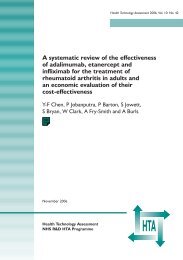Evaluation of liposomes coated with a pH responsive - University of ...
Evaluation of liposomes coated with a pH responsive - University of ...
Evaluation of liposomes coated with a pH responsive - University of ...
You also want an ePaper? Increase the reach of your titles
YUMPU automatically turns print PDFs into web optimized ePapers that Google loves.
which would protect the vesicles en route through the stomach and the small intestine. This<br />
general route to coating has been previously explored when anionic <strong>liposomes</strong> were <strong>coated</strong><br />
<strong>with</strong> the cationic polymer chitosan (Guo et al., 2003; Takeuchi et al., 1996, 2005), but no<br />
similar work has been completed using a <strong>pH</strong> <strong>responsive</strong> polymer for coating. The polymer<br />
Eudragit S100 was chosen as the coating material as it is widely used in both commercially<br />
available and experimental formulations for colonic targeting e.g. tablets (Khan et al., 1999<br />
and 2000), microspheres (Paharia et al., 2007) and capsules (Kraeling and Ritschel, 1992).<br />
The use <strong>of</strong> <strong>pH</strong> <strong>responsive</strong> materials for targeted oral delivery is not a perfect science and is<br />
not <strong>with</strong>out its drawbacks. For example, substantial inter-patient differences in <strong>pH</strong> can lead to<br />
unpredictable targeting and release (Ibekwe et al., 2008). In the case <strong>of</strong> Eudragit S100, the<br />
likelihood <strong>of</strong> inappropriately early release upstream <strong>of</strong> the colon can also be increased when<br />
partial neutralisation <strong>of</strong> the polymer’s acidic function groups is carried out to facilitate<br />
creation <strong>of</strong> an ‘aqueous dispersion’ for coating purposes (Ibekwe et al., 2006b). Hence<br />
although the coating method explored here was one involving only aqueous solutions,<br />
unmodified Eudragit S100, albeit at low concentration, has been used to reduce the risk <strong>of</strong><br />
drug release in the small intestine.<br />
Zeta potential measurements were used to monitor the evolution <strong>of</strong> the coat. This strategy has<br />
previously been used in the development <strong>of</strong> polymer-<strong>coated</strong> cationic and anionic liposomal<br />
formulations, where the point at which the zeta potential plateaus is taken to indicate<br />
saturation <strong>of</strong> the vesicle surface <strong>with</strong> polymer (Guo et al., 2003; Davidsen et al., 2001;<br />
Takeuchi et al., 2005). Results from our other studies (sizing, cryo-EM and drug release)<br />
indicate that such an assumption should be made <strong>with</strong> caution or that certainly further<br />
experimentation should always be carried out to provide information on the physical<br />
10
















